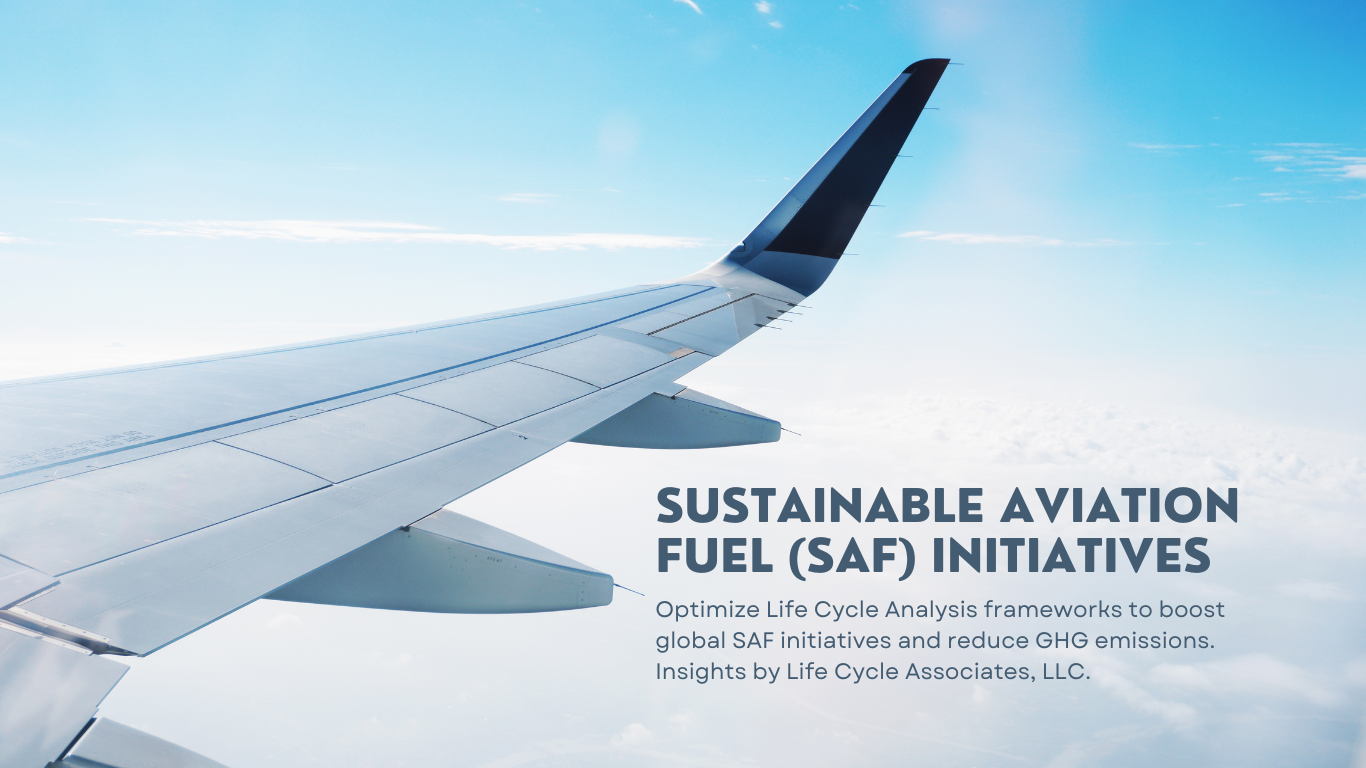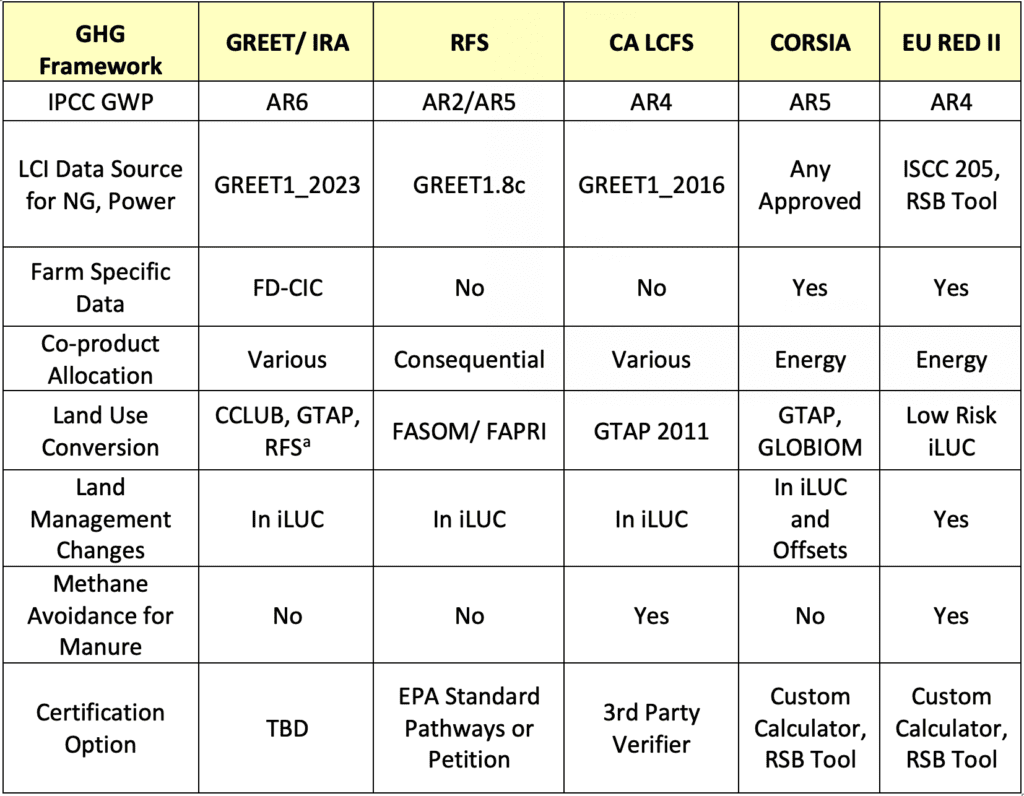Optimizing LCA Frameworks for Global SAF Initiatives

Leading aviation markets around the globe launched sustainable aviation fuel (SAF) initiatives over the past few years. Enthusiasm toward decarbonizing the sector led to the development of policies and incentives governed by unique minimum greenhouse gas (GHG) emission reduction requirements.
For international carriers, many of which announced their own GHG reduction commitments, navigating the unique bevy of policies presents a particular challenge within the sector.
These policies generally provide an incentive for greenhouse gas (GHG) reductions or require a reduction in GHG emissions relative to a petroleum fuel baseline. The range of incentives include tax credits, GHG reduction incentives, and volume obligations. Optimizing the life cycle analysis (LCA) frameworks of these global SAF initiatives will be key to unlocking profitable growth for companies throughout the sector’s value chain.
| Country | Policy | Usage Goal | Policy Drivers |
| United States | 2021 Aviation Climate Action Plan | 3 billion gallons by 2030, 35 billion gallons by 2050 | IRA Section 40B through 2024 & 45Z through 2027 |
| Renewable Fuel Standard | 36 billion gallons renewable fuels | RIN generation depending on fuel/feedstocks | |
| European Union | ReFuelEU Aviation | 2% SAF use in 2025, 6% in 2030, 20% in 2035, 70% in 2050 | Contributes to REDII obligation |
| Canada | Aviation Climate Action Plan, 2022-2030 | 10% SAF use by 2030, net zero by 2050 | National Clean Fuels Regulation (CFR) and BC LCFS |
| State Programsa | California Low Carbon Fuel Standard (LCFS) | Proposed 88% reduction by 2045 from 2024 | Proposed compliance curve, credit prices |
| Washington Clean Fuel Standard (CFS) | 20% reduction by 2034 from 2017 |
a Other LCFS programs include Oregon and British Columbia.
Frameworks for Low Carbon SAF
Different frameworks for assessing low carbon SAF are required for compliance with regulatory programs and incentives. The GHG emissions depend on the scope of analysis including whether iLUC is included or even if upstream lifecycle emissions are included. GREET, RFS, LCFS, CORSIA and RED all require reporting on a well to wake (WTW) basis.
The differences amongst these frameworks include inclusion of land use conversion, allocation methods and upstream lifecycle factors. Some rules of the certification system also affect transportation including the consideration of empty back hauls, and other factors like methane avoidance as shown in the following table.

a 40B calculator includes iLUC results from GREET plus other iLUC categories including methane from livestock and rice.
While these frameworks provide structure and support for the aviation industry to maximize these GHG reduction potentials, the wide range of analysis requirements inherently lead to inconsistent reporting of SAF emissions. Globally, aviation contributes 2% of all carbon dioxide (CO2) emissions and 12% of CO2 emissions within the transportation sector. Using 100% SAF could reduce GHG emissions by up to 94%, depending on the feedstock and technology pathway. Ensuring interoperability across these various frameworks will be a leading factor for achieving the GHG emission reduction potential for the aviation sector.
LCA Certification Tools/Methods
LCA certifications and tools are essential for comprehensively evaluating the environmental impacts of products and processes throughout their entire life cycle on a WTW basis. By adhering to standardized methodologies, such as those set by the International Standards Organization (ISO), these certifications ensure consistency, reliability, and credibility in the assessment results.
CORSIA
CORSIA is an ICAO (International Civil Aviation Organization) initiative with the goal to achieve carbon-neutral growth from a 2020 baseline through the adoption of credits or CORSIA eligible fuels (CEF). A CEF must meet certain sustainability requirements, which includes a CI reduction of at least 10% relative to a conventional jet fuel baseline. SAF is a drop-in replacement fuel for conventional jet fuel within the CEF category, made from feedstocks including oils and fats, biomass, municipal solid waste, other waste resources, and even renewable power and waste CO2.
For SAF to qualify under CORSIA, an LCA can be conducted with the International Sustainability and Carbon Certification (ISCC) CORSIA methodology or with a specialized calculator developed by the Roundtable on Sustainable Biomaterials (RSB). Upstream life cycle data may be drawn from one of the approved sources including the GREET model. Under CORSIA, indirect land use conversion (iLUC) values are derived from the Global Trade Analysis Project (GTAP) and Global Biosphere Management Mode (GLOBIOM) models. The CORSIA LCA methodology is also used under the IRA.
CA LCFS Tier 1 Calculator
California’s LCFS program sets GHG reduction targets on transportation fuels that are expected to be met through the substitution of lower CI renewable fuels for higher CI conventional fuels and by technology substitution. Currently, LCA analysis is performed using CA-GREET3.0 and CARB’s Tier 1 Calculators. The LCI data in CA-GREET3.0 and the Tier 1 Calculators are derived from GREET1_2016 with LUC values developed by CARB in 2015 based on the GTAP model.
EU RED
The EU implemented the Renewable Energy Directive (RED) to promote and support the adoption of renewable energy sources. This set of regulations utilizes different strategies, such as free attribution, mass balance, and book and claim credits, to monitor and incentivize the use of renewable biofuels. Similar LCA tools and the RSB tool used for CORSIA compliance is also similar to EU RED. EU RED does not include iLUC emissions as feedstocks with high risk of creating significant GHG emissions due to land use change are not allowed under the program.
IRA – 40BSAF calculator
The IRA 40BSAF-GREET 2024 is based on the Greenhouse gases, Regulated Emissions, and Energy use in Technologies (R&D GREET) model developed and maintained by Argonne National Laboratory. The SAF specific calculator is used to evaluate the emissions reduction percentage of feedstock-specific SAF production pathways. Through 2024, SAF is eligible for a standalone blender’s credit under Section 40B, provided the fuel achieves at least a 50 percent reduction in GHG emissions. The value of the credit is calculated on a sliding scale, starting at $1.25 per gallon, and adds $0.01 for each percentage point below 50 percent. From 2025 to 2027, SAF incentives will be incorporated into Section 45Z, which is expected to have its own unique GREET calculator.
Conclusions
U.S. SAF production hit a record of nearly 275 million gallons per year in 2023, with 50% growth forecasted in 2024 and year over year growth forecasted to double in 2025. While production reached a record, penetration into the fuel supply remains low, well below 1%. The consistent implementation and interoperability between the range of policies, incentives, and GHG frameworks will support global uptake of the market, especially as targets and mandates reach their deadlines. Unlocking more commercially competitive SAF pathways, in compliance with the respective LCA framework will bolster further adoption allowing the industry to fully takeoff.
Life Cycle Associates is a trusted partner for clients worldwide, assisting in emissions reduction and environmental impact mitigation. Our expertise lies in life cycle greenhouse gas emission analysis of fuel and energy production pathways, with extensive use of models such as GREET, IRA 40BSAF-GREET, and GTAP.
We offer services that include the modification of the California GREET model, development of initial pathway documents for the LCFS, support for fuel pathways under the LCFS, RFS2, and EU Renewable Energy Directive (RED), as well as determining the applicability of Inflation Reduction Act (IRA) provisions. A significant portion of our work in biofuels and other alternative fuels concerns the evaluation of new fuel production technologies, their energy balance, and economics.
Please let us know if you have a question or would like further information about Life Cycle Associates’ work and services.
This article was originally published in Sustainable Aviation Futures.
Authors: Brian D. Healy and Stefan Unnasch, Life Cycle Associates, LLC
